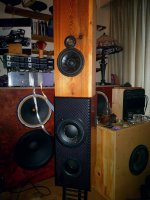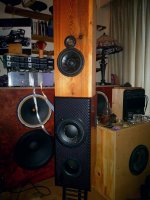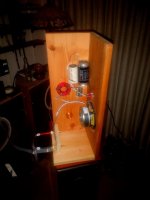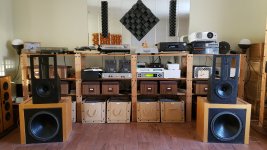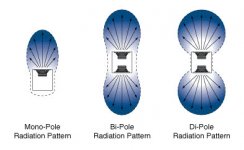wow very beautiful the wooden baffle! Yes a lot of similarity,Thanks for info.
I do have 4way open baffle in the main system now with two 15" woofers going up to 150Hz, then 8" betsy to 900Hz, then 8" slim planar to 3" planar. Lots of similarities.
with the difference of the 8" mid low you have and me don't. Very beautiful also the four wooden rear panel... do you have some measure ? But where's the mid-high planars?
Here some measure at 50, 100 and 200cm from the rear wall:robixxx1, I'm interested in how the nude 15" really measures and behaves in a room, near the floor and walls... is it AE ?Dipole15 - Open Baffle Applications - Acoustic Elegance woofer
Here is Edge sim of it in free air. It takes 15 dB eq to 50Hz
8" planar to 3" planar crossed at 9000HzThanks for info.
I do have 4way open baffle in the main system now with two 15" woofers going up to 150Hz, then 8" betsy to 900Hz, then 8" slim planar to 3" planar. Lots of similarities.
I am thinking about changing my down firing, ceiling hung foam core DMLs to same size (2x2 feet) 2-way OB speakers. Problem is they would have to hang extremely close- I don't think the face of the baffle could be any more than 6" from the ceiling without my wife complaining (they are in the kitchen where we listen to most of our music). I'm not too worried about bass response as I have a subwoofer and DSP, but I would def like the panels to go lower than the ~300Hz my DMLs currently do, and if possible I would love the panels to basically go full range (maybe down to 40-50 Hz) which would open up more options (I have 2 ZOUDIO panel amps I could bi amp each pair with for example).
I guess the TL;DR of my post is what are the effects of running an OB speaker extremely close to the back wall (like ~150cm/6") and what are my options for shallow depth drivers? If I can get clearance for more clearance maybe this won't be an issue but I'm planning for the worst.
I guess the TL;DR of my post is what are the effects of running an OB speaker extremely close to the back wall (like ~150cm/6") and what are my options for shallow depth drivers? If I can get clearance for more clearance maybe this won't be an issue but I'm planning for the worst.
It seems to be a mission impossible... How large can you go with the woofer to have 6" depth? say max 8"? But in any case, with only 6" of space between the woofer and the ceyling you will have a resonat cavity at about 1kHz... Beyond this, to have a response staring from 40-50Hz, with a little woofer, I think it should be possibile only at a very moderate level, you have to equalize it very deeply, so the power handling will be very little... you can check the sound with your actula speakers, removing it from the ceyling and applying eq with dsp... if you like the result, the you can go for a new woofer...I am thinking about changing my down firing, ceiling hung foam core DMLs to same size (2x2 feet) 2-way OB speakers. Problem is they would have to hang extremely close- I don't think the face of the baffle could be any more than 6" from the ceiling without my wife complaining (they are in the kitchen where we listen to most of our music). I'm not too worried about bass response as I have a subwoofer and DSP, but I would def like the panels to go lower than the ~300Hz my DMLs currently do, and if possible I would love the panels to basically go full range (maybe down to 40-50 Hz) which would open up more options (I have 2 ZOUDIO panel amps I could bi amp each pair with for example).
I guess the TL;DR of my post is what are the effects of running an OB speaker extremely close to the back wall (like ~150cm/6") and what are my options for shallow depth drivers? If I can get clearance for more clearance maybe this won't be an issue but I'm planning for the worst.
There are actually good OB 15" woofers that fit that clearance, so that is no issue. I will probably apply some absorption material to the back of the planar driver to reduce its rear wave output and all those resonances.It seems to be a mission impossible... How large can you go with the woofer to have 6" depth? say max 8"? But in any case, with only 6" of space between the woofer and the ceyling you will have a resonat cavity at about 1kHz... Beyond this, to have a response staring from 40-50Hz, with a little woofer, I think it should be possibile only at a very moderate level, you have to equalize it very deeply, so the power handling will be very little... you can check the sound with your actula speakers, removing it from the ceyling and applying eq with dsp... if you like the result, the you can go for a new woofer...
Honestly everything is cheap and easy enough that I think I'm just going to build a pair and see how they sound. I already have an idea for another place I can use them....
the problem to me is not the depth of the woofer but the depth of the cavity... an idea: perhaps you can try a cardiod design instead of a dipole one, filling the whole cavity with dumping material and so mantaining an openbaffle structure. I've read something about making a cardiod woofer with dumping material (not with an open baffle woofer + closed boxed woofer ) on Linkwitz site: https://www.linkwitzlab.com/H-U%20woofer2.htm , and the feltmetal material he's talking about: https://technetics.com/products/feltmetal-acoustic-media/There are actually good OB 15" woofers that fit that clearance, so that is no issue. I will probably apply some absorption material to the back of the planar driver to reduce its rear wave output and all those resonances.
Honestly everything is cheap and easy enough that I think I'm just going to build a pair and see how they sound. I already have an idea for another place I can use them....
I've been experimenting over the last few days and removed the baffle from the FR and pushed the XO from 225Hz to 400Hz. Imaging improved with no baffle on the FR but I had a hole in the response between 300-500Hz, moving the XO up fixed this but the W frame woofer has a cavity resonance at 300Hz which is now being excited. It still sounds much better and imaging improved further with the higher XO.
Next is to remove the woofers from the W frame.
Next is to remove the woofers from the W frame.
When I've removed mine from u-frame I've never came back... Initially could be seems that there is a lack in the mid bass, but what is missing is only the resonance from the cavity... With your W300 I think you can go up to 1kHz, so there shouldn't be any problem to compensate for the hole in the mid bass.I've been experimenting over the last few days and removed the baffle from the FR and pushed the XO from 225Hz to 400Hz. Imaging improved with no baffle on the FR but I had a hole in the response between 300-500Hz, moving the XO up fixed this but the W frame woofer has a cavity resonance at 300Hz which is now being excited. It still sounds much better and imaging improved further with the higher XO.
Next is to remove the woofers from the W frame.
I have bought 2x 2x4 MiniDSP's to use 3 or 4 way XO's and another class D amplifier for the woofer. The plan is to remove the woofers from the W frame and hang them from a metal frame. I have also bought 2x ribbon tweeters so I can turn my OB's into a 3 way speaker with 24dB/oct LW XO's. Currently the cheap Jaycar tweeter is XO at 4200Hz with a single capacitor (6dB/oct) and no XO on the FR, so there is a bit of graininess in the highs, but it does prove a tweeter is needed even with a good quality FR like the Mark Audio Alpair 12p.
The Mark Audio 12p with no baffle plays down to 400Hz so this is where I have set the XO. I have XOed the woofer currently at 300Hz to tame the cavity resonance until the new DSP's and power amplifier arrive.
The plan is the XO from 12p to tweeter just before the 12p starts to beam. I measured this yesterday so the XO will be about 2500Hz. I'll set the woofer XO at the natural rolloff of the 12p.
I have almost finished one of Planet10's small enclosures for the Alpair 12p to test with the naked woofers. So lots of experimenting to come.
This plot is the Mark Audio 12p with no baffle on axis at 500mm from the dust cap with no smoothing.

The Mark Audio 12p with no baffle plays down to 400Hz so this is where I have set the XO. I have XOed the woofer currently at 300Hz to tame the cavity resonance until the new DSP's and power amplifier arrive.
The plan is the XO from 12p to tweeter just before the 12p starts to beam. I measured this yesterday so the XO will be about 2500Hz. I'll set the woofer XO at the natural rolloff of the 12p.
I have almost finished one of Planet10's small enclosures for the Alpair 12p to test with the naked woofers. So lots of experimenting to come.
This plot is the Mark Audio 12p with no baffle on axis at 500mm from the dust cap with no smoothing.
Folded open baffle plus a ported "midbass coupler" as satellite to a subwoofer.
The two sections and sub are both using active crossovers, but the top L baffle is passively crossed, 3rd order Butterworth highpassed tweeter, 2nd order Butterworth midrange.
The active crossovers are Linkwitz Riley 4th order.
I like the folded baffle, as it keeps some surface area and provides less frontwall shadow for reflections.
I couldn't get the midbass coupler to voice properly without porting, and these specific stand heights.
Spacing is at about the maximum I could do and maintain little comb filtering between the woofers.
I reluctantly gave in to leaving sealed behind, and the cabinet is tuned for 55 hertz, and crossed actively to an 80 hertz and down sub.
The two sections and sub are both using active crossovers, but the top L baffle is passively crossed, 3rd order Butterworth highpassed tweeter, 2nd order Butterworth midrange.
The active crossovers are Linkwitz Riley 4th order.
I like the folded baffle, as it keeps some surface area and provides less frontwall shadow for reflections.
I couldn't get the midbass coupler to voice properly without porting, and these specific stand heights.
Spacing is at about the maximum I could do and maintain little comb filtering between the woofers.
I reluctantly gave in to leaving sealed behind, and the cabinet is tuned for 55 hertz, and crossed actively to an 80 hertz and down sub.
Attachments
Hi
These are my latest no baffle speakers with an 18" H-baffle sub. The Sub is actually the table in the back.


All the important intellectual work was done by other people, where I especially have to thank Charlie Laub for introducing the idea of the Dayton Audio wave guided tweeter back to back. This is a very elegant solution for constant directivity in the treble region. I like it better than the cheap GRS planar I tried before. That one measures and sounds worse, at least to my ears.
The higher midrange driver is a Satori 6,5" woofer and the lower midrange a Faital 400Pro.
The sub is a sb audience bianco 18" woofer.
My listening distance is roughly 2,50 meters and the speakers are ca 1 meter in front of the wall and toed in. The subwoofer is toed in a little as well, that reduces room modes at the listening position a great deal.
The right speaker measures like that in the listening position:

Step Response:

Impulse response:

Spectrogram:
 Phase, IR and step response is reworked with rePhase and the resulting IR is inserted in the signal chain via Camilla. (edit: But I am still not sure if this is really an auditory improvement or just different, sometimes it feels as it sounds a little bit artificial)
Phase, IR and step response is reworked with rePhase and the resulting IR is inserted in the signal chain via Camilla. (edit: But I am still not sure if this is really an auditory improvement or just different, sometimes it feels as it sounds a little bit artificial)
Directivity is as expected, these are the three drivers on the stand rotated from 0 to 90 degrees, measured a meter away in the room:

It is a very pleasing sounding speaker system now in my ca. 35 square meter, live sounding room. It took me some time to get the crossovers right for my ears, I started out with regular 24dB LR crossovers but ended up with roughly 12 dB asymmetric Bessel at 2100Hz from tweeters to midrange and at 400Hz from mid to low mid. The sub crosses at 100Hz steeper. Crossovers are made with two of those dsps, in that area might be room for improvement, better DA converters than those might make a difference, even though the speakers sound spectacular as is. This is the configuration I am going to live with for a while.
Thanks to everybody who made that project possible and merry christmas
These are my latest no baffle speakers with an 18" H-baffle sub. The Sub is actually the table in the back.
All the important intellectual work was done by other people, where I especially have to thank Charlie Laub for introducing the idea of the Dayton Audio wave guided tweeter back to back. This is a very elegant solution for constant directivity in the treble region. I like it better than the cheap GRS planar I tried before. That one measures and sounds worse, at least to my ears.
The higher midrange driver is a Satori 6,5" woofer and the lower midrange a Faital 400Pro.
The sub is a sb audience bianco 18" woofer.
My listening distance is roughly 2,50 meters and the speakers are ca 1 meter in front of the wall and toed in. The subwoofer is toed in a little as well, that reduces room modes at the listening position a great deal.
The right speaker measures like that in the listening position:
Step Response:
Impulse response:
Spectrogram:
Directivity is as expected, these are the three drivers on the stand rotated from 0 to 90 degrees, measured a meter away in the room:
It is a very pleasing sounding speaker system now in my ca. 35 square meter, live sounding room. It took me some time to get the crossovers right for my ears, I started out with regular 24dB LR crossovers but ended up with roughly 12 dB asymmetric Bessel at 2100Hz from tweeters to midrange and at 400Hz from mid to low mid. The sub crosses at 100Hz steeper. Crossovers are made with two of those dsps, in that area might be room for improvement, better DA converters than those might make a difference, even though the speakers sound spectacular as is. This is the configuration I am going to live with for a while.
Thanks to everybody who made that project possible and merry christmas
Last edited:
Does it make an audible difference which side the fold is on?Folded open baffle passive top, ported actively bandpassed midbass middle, actively lowpassed push pull bipole sub.
Hello adason.Thanks for info.
I do have 4way open baffle in the main system now with two 15" woofers going up to 150Hz, then 8" betsy to 900Hz, then 8" slim planar to 3" planar. Lots of similarities.
Are you using a baffle or baffleless? I guess there is a baffle for the 8" to do 150 to 900Hz.
Would be great to see a picture.
Which 15" and 8"?
I use small baffle for 15" woofers, and I have two of them per side, one after another. Just like emerald physics or legacy audio whisper.
All is posted on my web page, but the signature disappeared. I can post a picture.
My bass is best i achieved so far, tight, clean, well defined, not boomy, flat to 20Hz, because I eq with ultracurve. My other systems have normal closed boxes or U shape open baffle, and I hear some boom in those.
Cheers.
All is posted on my web page, but the signature disappeared. I can post a picture.
My bass is best i achieved so far, tight, clean, well defined, not boomy, flat to 20Hz, because I eq with ultracurve. My other systems have normal closed boxes or U shape open baffle, and I hear some boom in those.
Cheers.
Last edited:
Thank you!I do not claim my open baffle is ultimate, but i am very happy with the sound.
So two 15" per side, both "looking forward", in phase, open baffle? How does the airspace between both 15" behave? Do you get +3dB vs using a single 15"?
Kind of surprised not to see MTM in your design 😀. I've seem many designs by you in MTM (and I also like it)
See post #5, emerald physics, woofers are in tandem, one after another, but back to back, to lower the distortion. They are working as dipole, in unisono, sort of like isobaric, but not closed.
I used to have web page describing it, but geocities took it down. It can be found on wayback engine.
Yes, i have many mtm projects finished with great results, see bottom left in the image. I do rotate speakers, just like amps. For fun. Now i am enjoying some planars.
I used to have web page describing it, but geocities took it down. It can be found on wayback engine.
Yes, i have many mtm projects finished with great results, see bottom left in the image. I do rotate speakers, just like amps. For fun. Now i am enjoying some planars.
In bipole, woofers are working against each other. They generate equal polarity on both sides.
Big pressure changes in the cabinet.
In dipole, positive and negative sound wave is created, but no pressure changes inside. Inside is actually not a box. There is bridge around like in SL (rip) open baffle. To hold midbass above.
I used to have data to support that in dipole, there is better low fr extension. Make sense, woofers are not fighting against each other.
Big pressure changes in the cabinet.
In dipole, positive and negative sound wave is created, but no pressure changes inside. Inside is actually not a box. There is bridge around like in SL (rip) open baffle. To hold midbass above.
I used to have data to support that in dipole, there is better low fr extension. Make sense, woofers are not fighting against each other.
Attachments
Mmm...in the picture you attached the drivers are back to back both in bipole and dipole. You mentioned isobaric, where (per my understanding) drivers are back to front (both drivers facing the same direction), wired in phase and there is a sealed space between drivers, and the big advantage is the box is half as big as if one driver was used.In bipole, woofers are working against each other. They generate equal polarity on both sides.
Big pressure changes in the cabinet.
In dipole, positive and negative sound wave is created, but no pressure changes inside. Inside is actually not a box. There is bridge around like in SL (rip) open baffle. To hold midbass above.
I used to have data to support that in dipole, there is better low fr extension. Make sense, woofers are not fighting against each other.
I guess in your OB there is no sealed space between drivers, but are they front to forward and wired in phase? And the advantage is lowered distortion, added sensitivity or other? Probably +3dB since 2 drivers in parallel halve the impedance. But not clear to me how the +/- pressure on both sides of two closely spaced drivers behaves.
- Home
- Loudspeakers
- Multi-Way
- Ultimate Open Baffle Gallery
